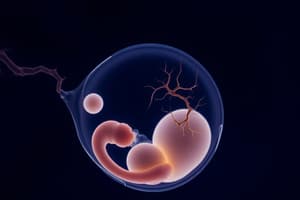Podcast
Questions and Answers
During gastrulation, what is the primary outcome of the dramatic cell movements and rearrangements?
During gastrulation, what is the primary outcome of the dramatic cell movements and rearrangements?
- Formation of the blastocoel
- Differentiation of the neural tube
- Partitioning of the zygote into blastomeres
- Establishment of the three primary germ layers (correct)
Cell differentiation is most accurately defined as the process by which cells:
Cell differentiation is most accurately defined as the process by which cells:
- Undergo rapid mitotic divisions without growth.
- Become specialized in structure and function. (correct)
- Increase in size to accommodate new organelles.
- Migrate to form new tissues and organs.
The Wnt signaling pathway plays a crucial role in cell differentiation by primarily influencing:
The Wnt signaling pathway plays a crucial role in cell differentiation by primarily influencing:
- Cell fate and tissue polarity (correct)
- DNA methylation
- Apoptosis
- Growth rate of the cell
What is the primary function of Homeotic (Hox) genes in animal development?
What is the primary function of Homeotic (Hox) genes in animal development?
Epigenetic modifications influence gene expression by:
Epigenetic modifications influence gene expression by:
Which of the following adult structures is NOT derived from the mesoderm?
Which of the following adult structures is NOT derived from the mesoderm?
During organogenesis, the apical ectodermal ridge (AER) and the zone of polarizing activity (ZPA) are critical for:
During organogenesis, the apical ectodermal ridge (AER) and the zone of polarizing activity (ZPA) are critical for:
Autonomous specification of cell fate is determined by:
Autonomous specification of cell fate is determined by:
MicroRNAs (miRNAs) regulate gene expression by:
MicroRNAs (miRNAs) regulate gene expression by:
Which event is most directly linked to neurulation?
Which event is most directly linked to neurulation?
Flashcards
Fertilization
Fertilization
Fusion of sperm and egg, forming a zygote and initiating embryonic development.
Cleavage (Embryonic)
Cleavage (Embryonic)
Rapid mitotic cell divisions without significant growth, partitioning the zygote's cytoplasm.
Blastulation
Blastulation
Organization of blastomeres into a hollow sphere with a fluid-filled cavity.
Gastrulation
Gastrulation
Signup and view all the flashcards
Neurulation
Neurulation
Signup and view all the flashcards
Organogenesis
Organogenesis
Signup and view all the flashcards
Cell Differentiation
Cell Differentiation
Signup and view all the flashcards
Autonomous Specification
Autonomous Specification
Signup and view all the flashcards
Conditional Specification
Conditional Specification
Signup and view all the flashcards
Organogenesis
Organogenesis
Signup and view all the flashcards
Study Notes
- Developmental biology examines how organisms grow and develop.
- Embryonic development is key in numerous organisms' life cycles.
- A single cell (zygote) transforms into a multicellular embryo via complex changes.
- These changes are cell division, cell differentiation, and morphogenesis.
- Orchestration relies on intricate genetic and molecular mechanisms.
Stages of Embryonic Development
- Fertilization starts the process by fusing sperm and egg, forming a zygote.
- Cleavage involves rapid mitotic cell divisions without growth.
- Cytoplasm is partitioned into smaller cells called blastomeres.
- Blastomeres form a hollow sphere called the blastula.
- Blastula features a fluid-filled cavity known as the blastocoel.
- Gastrulation is a critical stage involving cell movements and rearrangements.
- The three primary germ layers are formed: ectoderm, mesoderm, and endoderm.
- In chordates, neurulation involves the ectoderm folding inward to form the neural tube.
- The neural tube is a precursor to the central nervous system.
- Organogenesis involves germ layer interaction and differentiation.
- Organs and tissues of the body are formed in organogenesis.
Cell Differentiation
- Cell differentiation is cells specializing in structure and function.
- This is crucial for building complex multicellular organisms.
- Differentiation is managed by differential gene expression.
- Specific genes are activated or repressed in certain cells.
- Distinct protein sets are produced because of this.
- Cell fate determination involves cells committing to a developmental pathway.
- Determination occurs through autonomous, conditional, or syncytial specification.
- Autonomous specification is cell fate determined by cytoplasmic determinants.
- These determinants are inherited from the mother cell.
- Conditional specification is cell fate determined by neighboring cell interactions.
- Syncytial specification is cell fate determined by nuclei position within syncytium, especially in insects.
- Signaling pathways are crucial in cell differentiation.
- The Wnt pathway is vital for cell fate and tissue polarity.
- The Hedgehog pathway handles pattern formation and cell differentiation.
- The TGF-β pathway regulates cell growth, differentiation, and apoptosis.
- The Notch pathway is critical for cell fate decisions during development.
Genetic Regulation
- Genetic regulation manages the timing and spatial patterns of gene expression in development.
- Transcription factors, regulatory DNA sequences, and epigenetic modifications achieve this.
- Transcription factors bind to enhancers or silencers, either promoting or repressing gene transcription.
- Homeotic (Hox) genes are transcription factors vital for specifying body plans in animals.
- Mutations in Hox genes dramatically transform body segment identity.
- MicroRNAs (miRNAs) are small, non-coding RNAs modulate gene expression.
- miRNAs bind to messenger RNAs (mRNAs), inhibiting translation or promoting mRNA degradation.
- Epigenetic modifications like DNA methylation and histone modification alter gene expression without changing the DNA sequence.
Organogenesis
- Organogenesis is organ formation, where germ layers interact and differentiate into specific tissues.
- Ectoderm forms the epidermis, nervous system, and sensory organs.
- Mesoderm forms muscles, bones, blood, heart, kidneys, and reproductive organs.
- Endoderm forms the lining of the digestive tract, respiratory system, plus the liver and pancreas.
- Cell-cell interactions and signaling pathways coordinate organ development.
- Vertebrate limb formation involves ectoderm and mesoderm interactions.
- The apical ectodermal ridge (AER) is a specialized ectoderm promoting limb bud outgrowth.
- The zone of polarizing activity (ZPA) is a mesoderm specifying the anterior-posterior axis of the limb.
- Heart development involves cell movements and signaling, forming heart chambers and vessels.
- Errors in organogenesis can lead to congenital birth defects.
Studying That Suits You
Use AI to generate personalized quizzes and flashcards to suit your learning preferences.




